Leadership Approach and Governance Analysis - University Essay
VerifiedAdded on 2020/02/24
|11
|2341
|61
Essay
AI Summary
This essay delves into the multifaceted aspects of leadership and governance, beginning with an exploration of various leadership approaches. It identifies the trait approach as particularly valuable, emphasizing its focus on the inherent personality, mental, and physical traits of effective leaders. The essay then justifies the selection of this approach and conducts a comparative analysis of different leadership styles, ultimately advocating for a composite approach suitable for diverse decision-making scenarios. Furthermore, the paper highlights the transformational leadership style as the most efficient for enhancing self-assessment within an organization. The essay also examines the importance of developing essential leadership skills, such as initiative, critical thinking, effective listening, and motivation, and offers a self-assessment of these skills. Finally, the paper concludes by emphasizing the significance of obtaining feedback to refine the adopted leadership style.
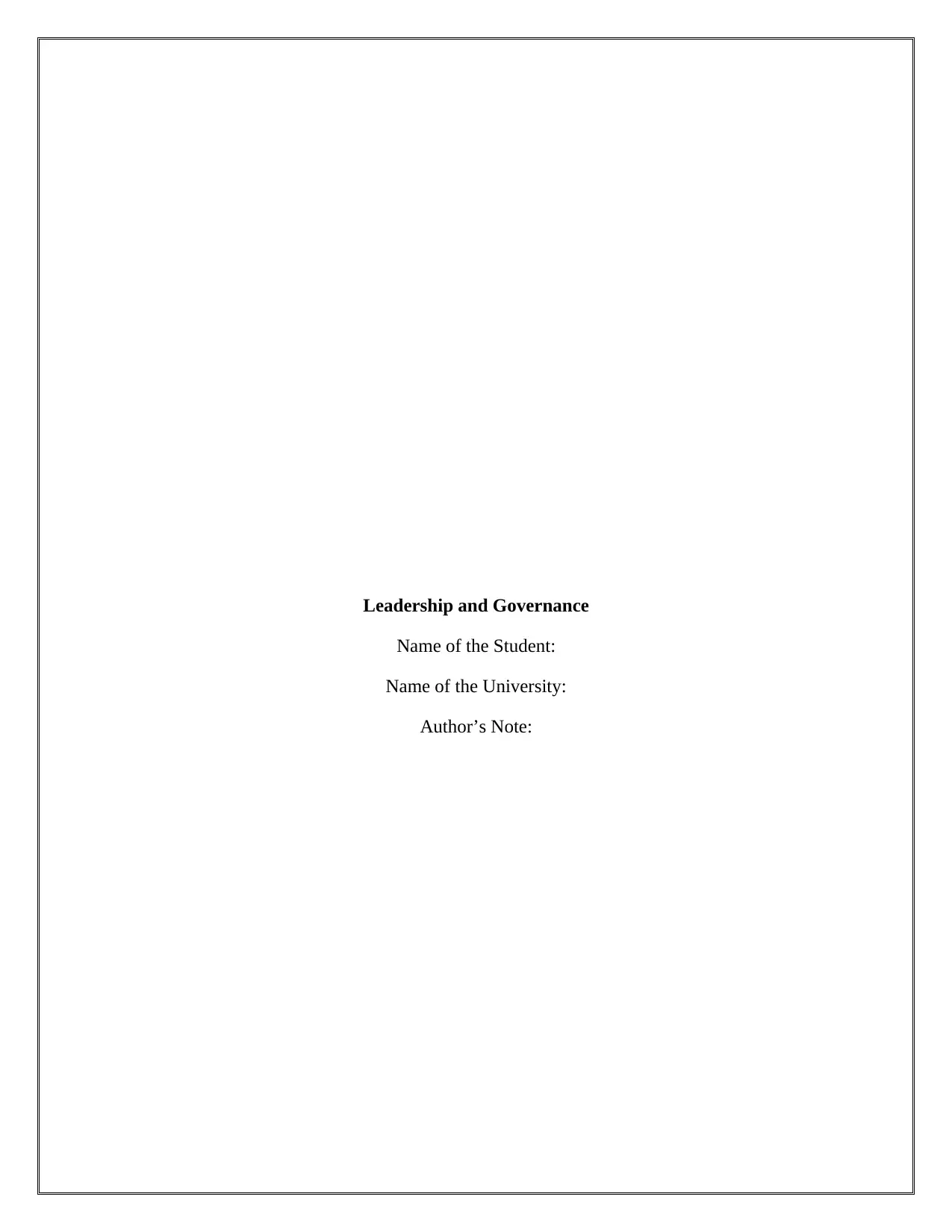
Leadership and Governance
Name of the Student:
Name of the University:
Author’s Note:
Name of the Student:
Name of the University:
Author’s Note:
Paraphrase This Document
Need a fresh take? Get an instant paraphrase of this document with our AI Paraphraser
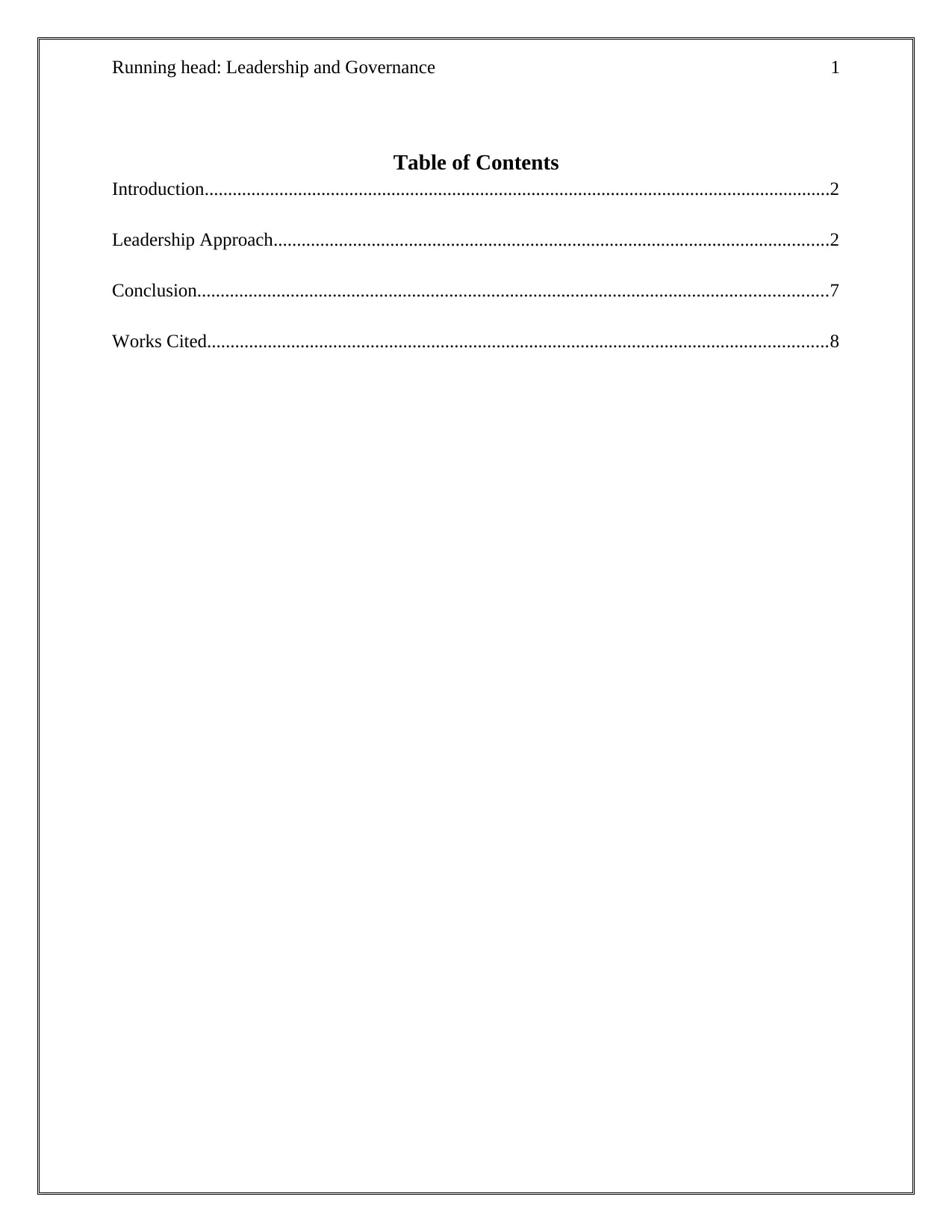
Running head: Leadership and Governance 1
Table of Contents
Introduction......................................................................................................................................2
Leadership Approach.......................................................................................................................2
Conclusion.......................................................................................................................................7
Works Cited.....................................................................................................................................8
Table of Contents
Introduction......................................................................................................................................2
Leadership Approach.......................................................................................................................2
Conclusion.......................................................................................................................................7
Works Cited.....................................................................................................................................8
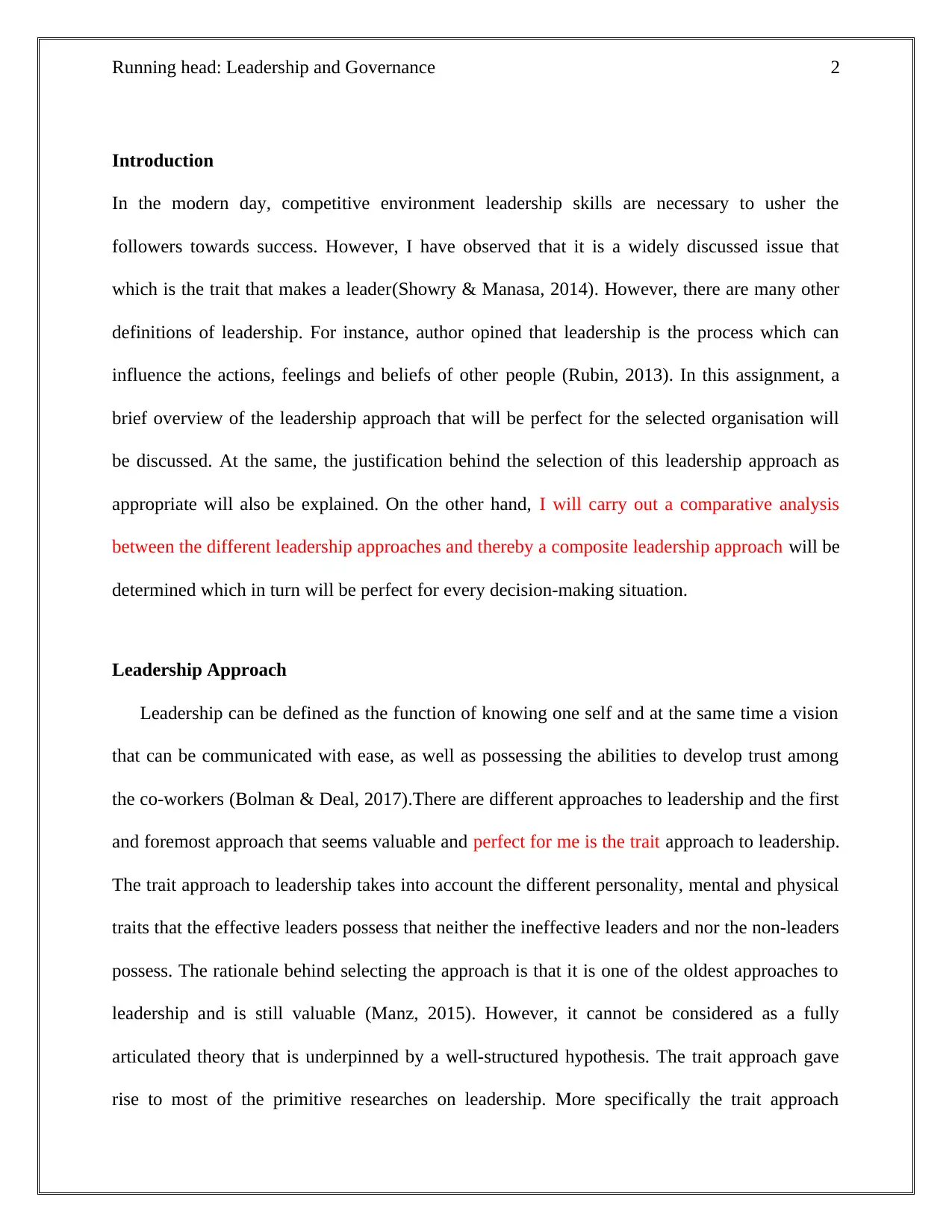
Running head: Leadership and Governance 2
Introduction
In the modern day, competitive environment leadership skills are necessary to usher the
followers towards success. However, I have observed that it is a widely discussed issue that
which is the trait that makes a leader(Showry & Manasa, 2014). However, there are many other
definitions of leadership. For instance, author opined that leadership is the process which can
influence the actions, feelings and beliefs of other people (Rubin, 2013). In this assignment, a
brief overview of the leadership approach that will be perfect for the selected organisation will
be discussed. At the same, the justification behind the selection of this leadership approach as
appropriate will also be explained. On the other hand, I will carry out a comparative analysis
between the different leadership approaches and thereby a composite leadership approach will be
determined which in turn will be perfect for every decision-making situation.
Leadership Approach
Leadership can be defined as the function of knowing one self and at the same time a vision
that can be communicated with ease, as well as possessing the abilities to develop trust among
the co-workers (Bolman & Deal, 2017).There are different approaches to leadership and the first
and foremost approach that seems valuable and perfect for me is the trait approach to leadership.
The trait approach to leadership takes into account the different personality, mental and physical
traits that the effective leaders possess that neither the ineffective leaders and nor the non-leaders
possess. The rationale behind selecting the approach is that it is one of the oldest approaches to
leadership and is still valuable (Manz, 2015). However, it cannot be considered as a fully
articulated theory that is underpinned by a well-structured hypothesis. The trait approach gave
rise to most of the primitive researches on leadership. More specifically the trait approach
Introduction
In the modern day, competitive environment leadership skills are necessary to usher the
followers towards success. However, I have observed that it is a widely discussed issue that
which is the trait that makes a leader(Showry & Manasa, 2014). However, there are many other
definitions of leadership. For instance, author opined that leadership is the process which can
influence the actions, feelings and beliefs of other people (Rubin, 2013). In this assignment, a
brief overview of the leadership approach that will be perfect for the selected organisation will
be discussed. At the same, the justification behind the selection of this leadership approach as
appropriate will also be explained. On the other hand, I will carry out a comparative analysis
between the different leadership approaches and thereby a composite leadership approach will be
determined which in turn will be perfect for every decision-making situation.
Leadership Approach
Leadership can be defined as the function of knowing one self and at the same time a vision
that can be communicated with ease, as well as possessing the abilities to develop trust among
the co-workers (Bolman & Deal, 2017).There are different approaches to leadership and the first
and foremost approach that seems valuable and perfect for me is the trait approach to leadership.
The trait approach to leadership takes into account the different personality, mental and physical
traits that the effective leaders possess that neither the ineffective leaders and nor the non-leaders
possess. The rationale behind selecting the approach is that it is one of the oldest approaches to
leadership and is still valuable (Manz, 2015). However, it cannot be considered as a fully
articulated theory that is underpinned by a well-structured hypothesis. The trait approach gave
rise to most of the primitive researches on leadership. More specifically the trait approach
⊘ This is a preview!⊘
Do you want full access?
Subscribe today to unlock all pages.

Trusted by 1+ million students worldwide
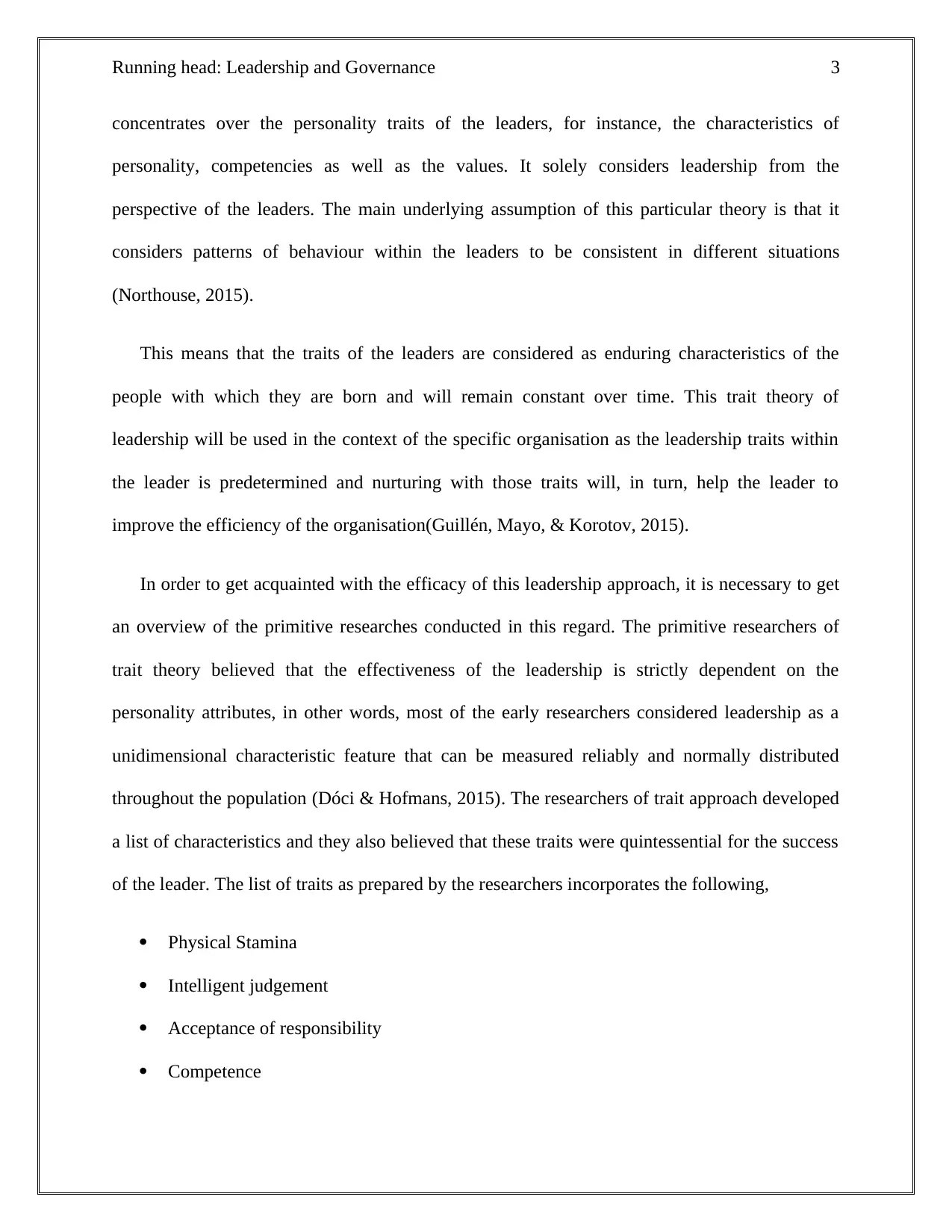
Running head: Leadership and Governance 3
concentrates over the personality traits of the leaders, for instance, the characteristics of
personality, competencies as well as the values. It solely considers leadership from the
perspective of the leaders. The main underlying assumption of this particular theory is that it
considers patterns of behaviour within the leaders to be consistent in different situations
(Northouse, 2015).
This means that the traits of the leaders are considered as enduring characteristics of the
people with which they are born and will remain constant over time. This trait theory of
leadership will be used in the context of the specific organisation as the leadership traits within
the leader is predetermined and nurturing with those traits will, in turn, help the leader to
improve the efficiency of the organisation(Guillén, Mayo, & Korotov, 2015).
In order to get acquainted with the efficacy of this leadership approach, it is necessary to get
an overview of the primitive researches conducted in this regard. The primitive researchers of
trait theory believed that the effectiveness of the leadership is strictly dependent on the
personality attributes, in other words, most of the early researchers considered leadership as a
unidimensional characteristic feature that can be measured reliably and normally distributed
throughout the population (Dóci & Hofmans, 2015). The researchers of trait approach developed
a list of characteristics and they also believed that these traits were quintessential for the success
of the leader. The list of traits as prepared by the researchers incorporates the following,
Physical Stamina
Intelligent judgement
Acceptance of responsibility
Competence
concentrates over the personality traits of the leaders, for instance, the characteristics of
personality, competencies as well as the values. It solely considers leadership from the
perspective of the leaders. The main underlying assumption of this particular theory is that it
considers patterns of behaviour within the leaders to be consistent in different situations
(Northouse, 2015).
This means that the traits of the leaders are considered as enduring characteristics of the
people with which they are born and will remain constant over time. This trait theory of
leadership will be used in the context of the specific organisation as the leadership traits within
the leader is predetermined and nurturing with those traits will, in turn, help the leader to
improve the efficiency of the organisation(Guillén, Mayo, & Korotov, 2015).
In order to get acquainted with the efficacy of this leadership approach, it is necessary to get
an overview of the primitive researches conducted in this regard. The primitive researchers of
trait theory believed that the effectiveness of the leadership is strictly dependent on the
personality attributes, in other words, most of the early researchers considered leadership as a
unidimensional characteristic feature that can be measured reliably and normally distributed
throughout the population (Dóci & Hofmans, 2015). The researchers of trait approach developed
a list of characteristics and they also believed that these traits were quintessential for the success
of the leader. The list of traits as prepared by the researchers incorporates the following,
Physical Stamina
Intelligent judgement
Acceptance of responsibility
Competence
Paraphrase This Document
Need a fresh take? Get an instant paraphrase of this document with our AI Paraphraser
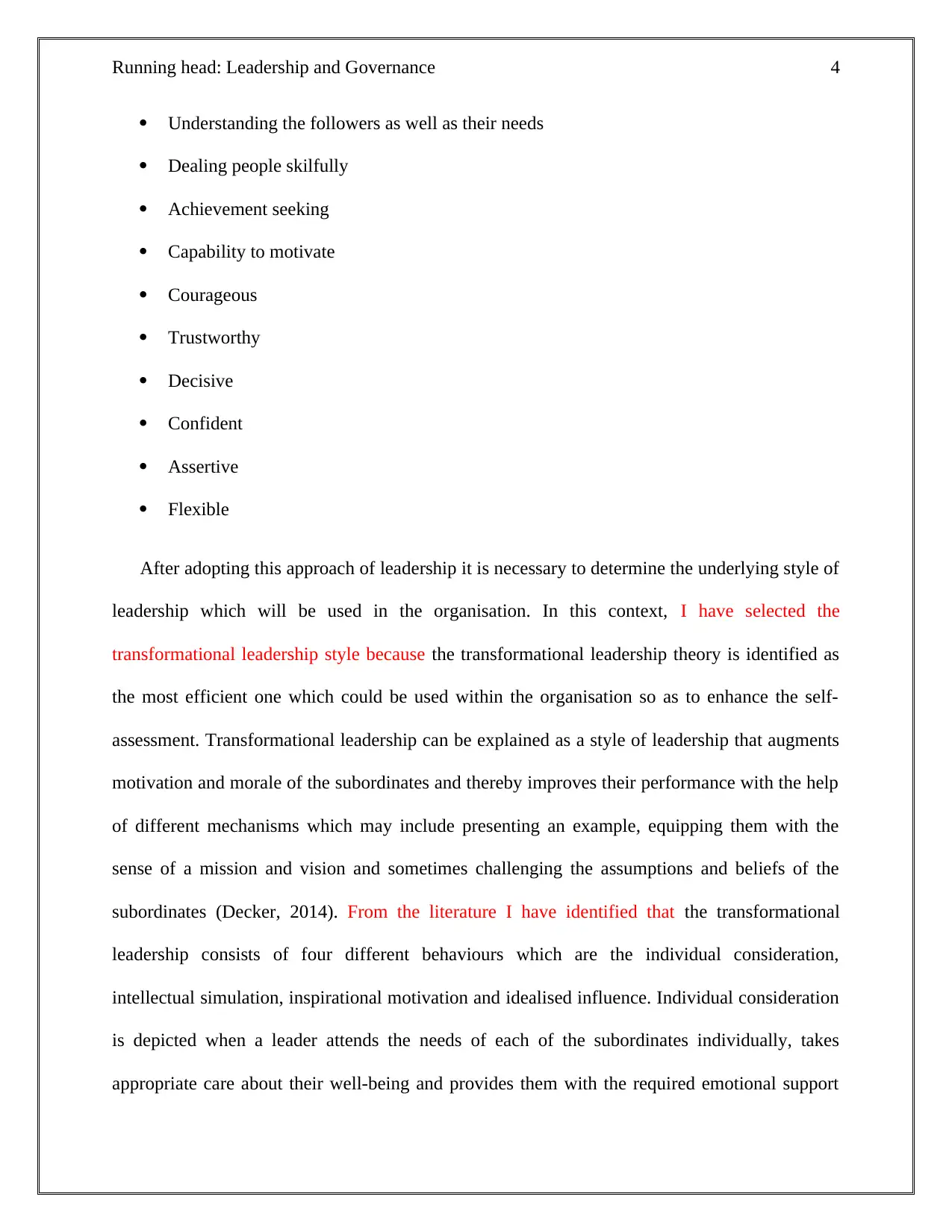
Running head: Leadership and Governance 4
Understanding the followers as well as their needs
Dealing people skilfully
Achievement seeking
Capability to motivate
Courageous
Trustworthy
Decisive
Confident
Assertive
Flexible
After adopting this approach of leadership it is necessary to determine the underlying style of
leadership which will be used in the organisation. In this context, I have selected the
transformational leadership style because the transformational leadership theory is identified as
the most efficient one which could be used within the organisation so as to enhance the self-
assessment. Transformational leadership can be explained as a style of leadership that augments
motivation and morale of the subordinates and thereby improves their performance with the help
of different mechanisms which may include presenting an example, equipping them with the
sense of a mission and vision and sometimes challenging the assumptions and beliefs of the
subordinates (Decker, 2014). From the literature I have identified that the transformational
leadership consists of four different behaviours which are the individual consideration,
intellectual simulation, inspirational motivation and idealised influence. Individual consideration
is depicted when a leader attends the needs of each of the subordinates individually, takes
appropriate care about their well-being and provides them with the required emotional support
Understanding the followers as well as their needs
Dealing people skilfully
Achievement seeking
Capability to motivate
Courageous
Trustworthy
Decisive
Confident
Assertive
Flexible
After adopting this approach of leadership it is necessary to determine the underlying style of
leadership which will be used in the organisation. In this context, I have selected the
transformational leadership style because the transformational leadership theory is identified as
the most efficient one which could be used within the organisation so as to enhance the self-
assessment. Transformational leadership can be explained as a style of leadership that augments
motivation and morale of the subordinates and thereby improves their performance with the help
of different mechanisms which may include presenting an example, equipping them with the
sense of a mission and vision and sometimes challenging the assumptions and beliefs of the
subordinates (Decker, 2014). From the literature I have identified that the transformational
leadership consists of four different behaviours which are the individual consideration,
intellectual simulation, inspirational motivation and idealised influence. Individual consideration
is depicted when a leader attends the needs of each of the subordinates individually, takes
appropriate care about their well-being and provides them with the required emotional support
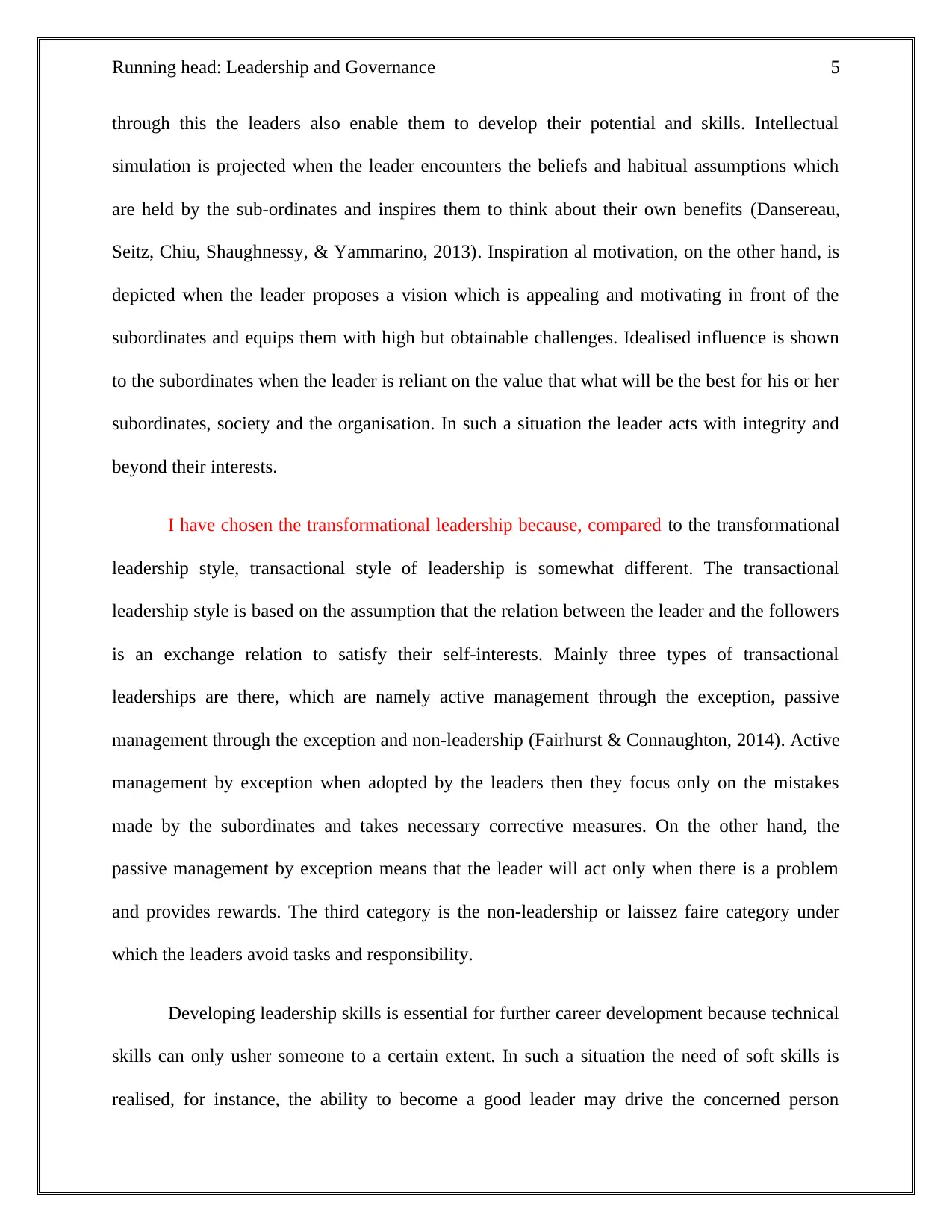
Running head: Leadership and Governance 5
through this the leaders also enable them to develop their potential and skills. Intellectual
simulation is projected when the leader encounters the beliefs and habitual assumptions which
are held by the sub-ordinates and inspires them to think about their own benefits (Dansereau,
Seitz, Chiu, Shaughnessy, & Yammarino, 2013). Inspiration al motivation, on the other hand, is
depicted when the leader proposes a vision which is appealing and motivating in front of the
subordinates and equips them with high but obtainable challenges. Idealised influence is shown
to the subordinates when the leader is reliant on the value that what will be the best for his or her
subordinates, society and the organisation. In such a situation the leader acts with integrity and
beyond their interests.
I have chosen the transformational leadership because, compared to the transformational
leadership style, transactional style of leadership is somewhat different. The transactional
leadership style is based on the assumption that the relation between the leader and the followers
is an exchange relation to satisfy their self-interests. Mainly three types of transactional
leaderships are there, which are namely active management through the exception, passive
management through the exception and non-leadership (Fairhurst & Connaughton, 2014). Active
management by exception when adopted by the leaders then they focus only on the mistakes
made by the subordinates and takes necessary corrective measures. On the other hand, the
passive management by exception means that the leader will act only when there is a problem
and provides rewards. The third category is the non-leadership or laissez faire category under
which the leaders avoid tasks and responsibility.
Developing leadership skills is essential for further career development because technical
skills can only usher someone to a certain extent. In such a situation the need of soft skills is
realised, for instance, the ability to become a good leader may drive the concerned person
through this the leaders also enable them to develop their potential and skills. Intellectual
simulation is projected when the leader encounters the beliefs and habitual assumptions which
are held by the sub-ordinates and inspires them to think about their own benefits (Dansereau,
Seitz, Chiu, Shaughnessy, & Yammarino, 2013). Inspiration al motivation, on the other hand, is
depicted when the leader proposes a vision which is appealing and motivating in front of the
subordinates and equips them with high but obtainable challenges. Idealised influence is shown
to the subordinates when the leader is reliant on the value that what will be the best for his or her
subordinates, society and the organisation. In such a situation the leader acts with integrity and
beyond their interests.
I have chosen the transformational leadership because, compared to the transformational
leadership style, transactional style of leadership is somewhat different. The transactional
leadership style is based on the assumption that the relation between the leader and the followers
is an exchange relation to satisfy their self-interests. Mainly three types of transactional
leaderships are there, which are namely active management through the exception, passive
management through the exception and non-leadership (Fairhurst & Connaughton, 2014). Active
management by exception when adopted by the leaders then they focus only on the mistakes
made by the subordinates and takes necessary corrective measures. On the other hand, the
passive management by exception means that the leader will act only when there is a problem
and provides rewards. The third category is the non-leadership or laissez faire category under
which the leaders avoid tasks and responsibility.
Developing leadership skills is essential for further career development because technical
skills can only usher someone to a certain extent. In such a situation the need of soft skills is
realised, for instance, the ability to become a good leader may drive the concerned person
⊘ This is a preview!⊘
Do you want full access?
Subscribe today to unlock all pages.

Trusted by 1+ million students worldwide
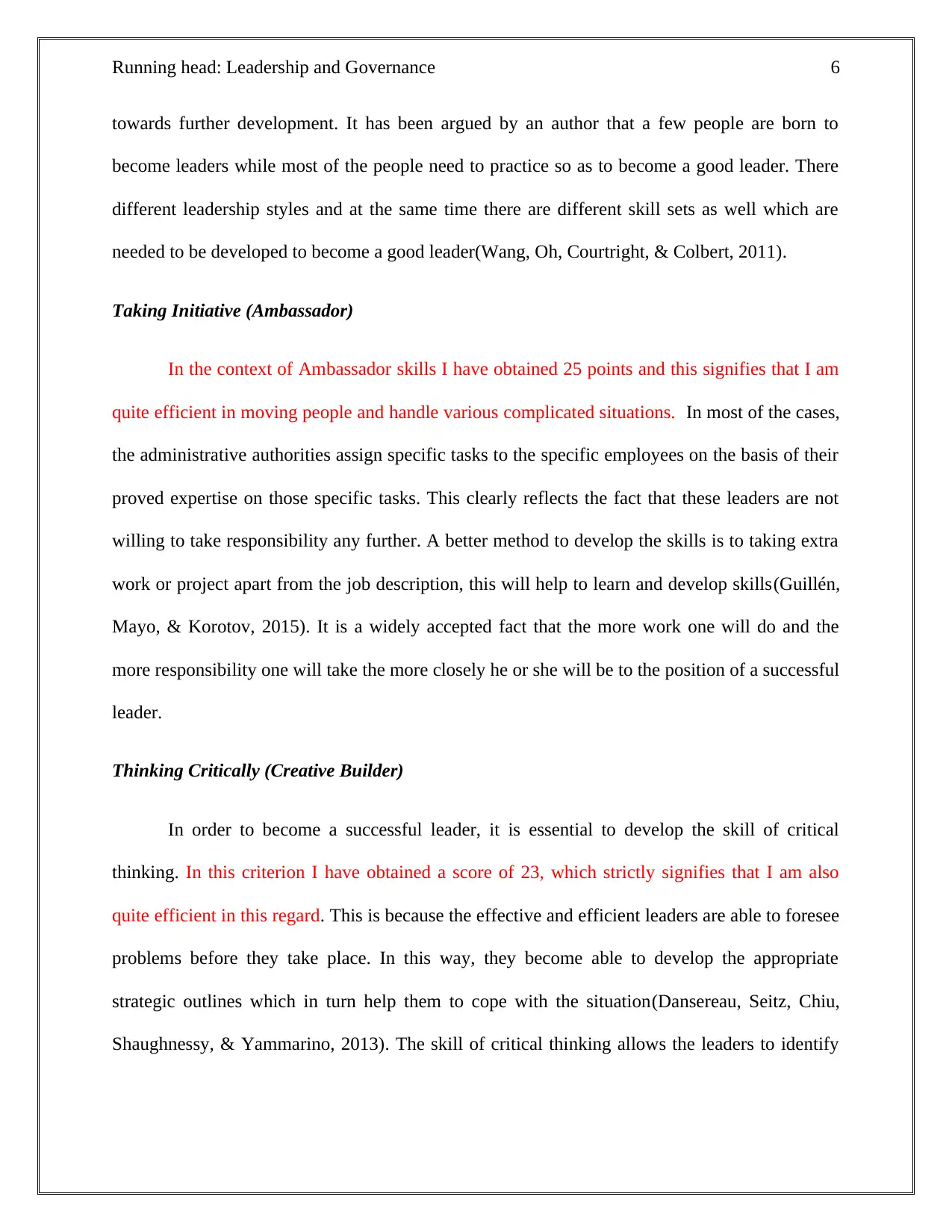
Running head: Leadership and Governance 6
towards further development. It has been argued by an author that a few people are born to
become leaders while most of the people need to practice so as to become a good leader. There
different leadership styles and at the same time there are different skill sets as well which are
needed to be developed to become a good leader(Wang, Oh, Courtright, & Colbert, 2011).
Taking Initiative (Ambassador)
In the context of Ambassador skills I have obtained 25 points and this signifies that I am
quite efficient in moving people and handle various complicated situations. In most of the cases,
the administrative authorities assign specific tasks to the specific employees on the basis of their
proved expertise on those specific tasks. This clearly reflects the fact that these leaders are not
willing to take responsibility any further. A better method to develop the skills is to taking extra
work or project apart from the job description, this will help to learn and develop skills(Guillén,
Mayo, & Korotov, 2015). It is a widely accepted fact that the more work one will do and the
more responsibility one will take the more closely he or she will be to the position of a successful
leader.
Thinking Critically (Creative Builder)
In order to become a successful leader, it is essential to develop the skill of critical
thinking. In this criterion I have obtained a score of 23, which strictly signifies that I am also
quite efficient in this regard. This is because the effective and efficient leaders are able to foresee
problems before they take place. In this way, they become able to develop the appropriate
strategic outlines which in turn help them to cope with the situation(Dansereau, Seitz, Chiu,
Shaughnessy, & Yammarino, 2013). The skill of critical thinking allows the leaders to identify
towards further development. It has been argued by an author that a few people are born to
become leaders while most of the people need to practice so as to become a good leader. There
different leadership styles and at the same time there are different skill sets as well which are
needed to be developed to become a good leader(Wang, Oh, Courtright, & Colbert, 2011).
Taking Initiative (Ambassador)
In the context of Ambassador skills I have obtained 25 points and this signifies that I am
quite efficient in moving people and handle various complicated situations. In most of the cases,
the administrative authorities assign specific tasks to the specific employees on the basis of their
proved expertise on those specific tasks. This clearly reflects the fact that these leaders are not
willing to take responsibility any further. A better method to develop the skills is to taking extra
work or project apart from the job description, this will help to learn and develop skills(Guillén,
Mayo, & Korotov, 2015). It is a widely accepted fact that the more work one will do and the
more responsibility one will take the more closely he or she will be to the position of a successful
leader.
Thinking Critically (Creative Builder)
In order to become a successful leader, it is essential to develop the skill of critical
thinking. In this criterion I have obtained a score of 23, which strictly signifies that I am also
quite efficient in this regard. This is because the effective and efficient leaders are able to foresee
problems before they take place. In this way, they become able to develop the appropriate
strategic outlines which in turn help them to cope with the situation(Dansereau, Seitz, Chiu,
Shaughnessy, & Yammarino, 2013). The skill of critical thinking allows the leaders to identify
Paraphrase This Document
Need a fresh take? Get an instant paraphrase of this document with our AI Paraphraser
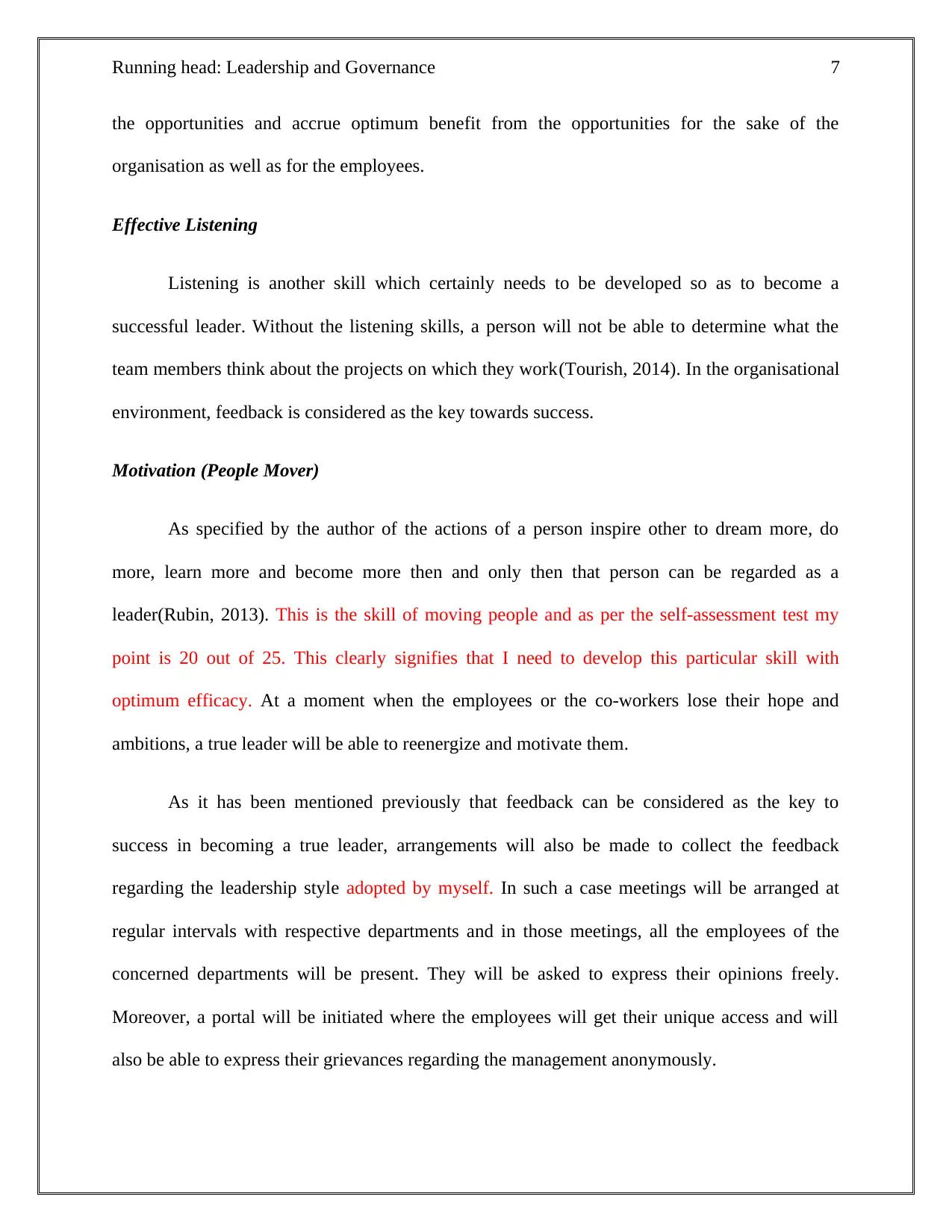
Running head: Leadership and Governance 7
the opportunities and accrue optimum benefit from the opportunities for the sake of the
organisation as well as for the employees.
Effective Listening
Listening is another skill which certainly needs to be developed so as to become a
successful leader. Without the listening skills, a person will not be able to determine what the
team members think about the projects on which they work(Tourish, 2014). In the organisational
environment, feedback is considered as the key towards success.
Motivation (People Mover)
As specified by the author of the actions of a person inspire other to dream more, do
more, learn more and become more then and only then that person can be regarded as a
leader(Rubin, 2013). This is the skill of moving people and as per the self-assessment test my
point is 20 out of 25. This clearly signifies that I need to develop this particular skill with
optimum efficacy. At a moment when the employees or the co-workers lose their hope and
ambitions, a true leader will be able to reenergize and motivate them.
As it has been mentioned previously that feedback can be considered as the key to
success in becoming a true leader, arrangements will also be made to collect the feedback
regarding the leadership style adopted by myself. In such a case meetings will be arranged at
regular intervals with respective departments and in those meetings, all the employees of the
concerned departments will be present. They will be asked to express their opinions freely.
Moreover, a portal will be initiated where the employees will get their unique access and will
also be able to express their grievances regarding the management anonymously.
the opportunities and accrue optimum benefit from the opportunities for the sake of the
organisation as well as for the employees.
Effective Listening
Listening is another skill which certainly needs to be developed so as to become a
successful leader. Without the listening skills, a person will not be able to determine what the
team members think about the projects on which they work(Tourish, 2014). In the organisational
environment, feedback is considered as the key towards success.
Motivation (People Mover)
As specified by the author of the actions of a person inspire other to dream more, do
more, learn more and become more then and only then that person can be regarded as a
leader(Rubin, 2013). This is the skill of moving people and as per the self-assessment test my
point is 20 out of 25. This clearly signifies that I need to develop this particular skill with
optimum efficacy. At a moment when the employees or the co-workers lose their hope and
ambitions, a true leader will be able to reenergize and motivate them.
As it has been mentioned previously that feedback can be considered as the key to
success in becoming a true leader, arrangements will also be made to collect the feedback
regarding the leadership style adopted by myself. In such a case meetings will be arranged at
regular intervals with respective departments and in those meetings, all the employees of the
concerned departments will be present. They will be asked to express their opinions freely.
Moreover, a portal will be initiated where the employees will get their unique access and will
also be able to express their grievances regarding the management anonymously.
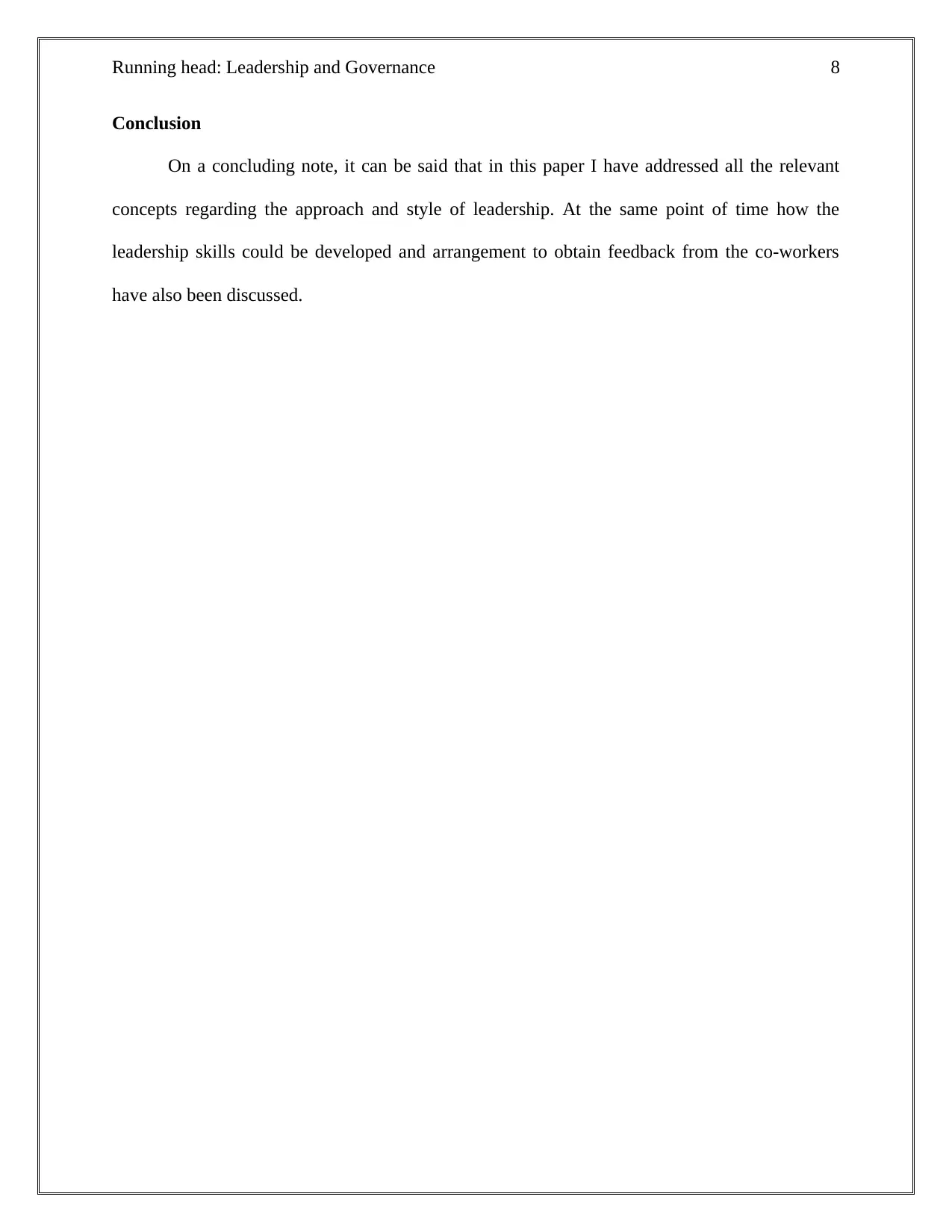
Running head: Leadership and Governance 8
Conclusion
On a concluding note, it can be said that in this paper I have addressed all the relevant
concepts regarding the approach and style of leadership. At the same point of time how the
leadership skills could be developed and arrangement to obtain feedback from the co-workers
have also been discussed.
Conclusion
On a concluding note, it can be said that in this paper I have addressed all the relevant
concepts regarding the approach and style of leadership. At the same point of time how the
leadership skills could be developed and arrangement to obtain feedback from the co-workers
have also been discussed.
⊘ This is a preview!⊘
Do you want full access?
Subscribe today to unlock all pages.

Trusted by 1+ million students worldwide
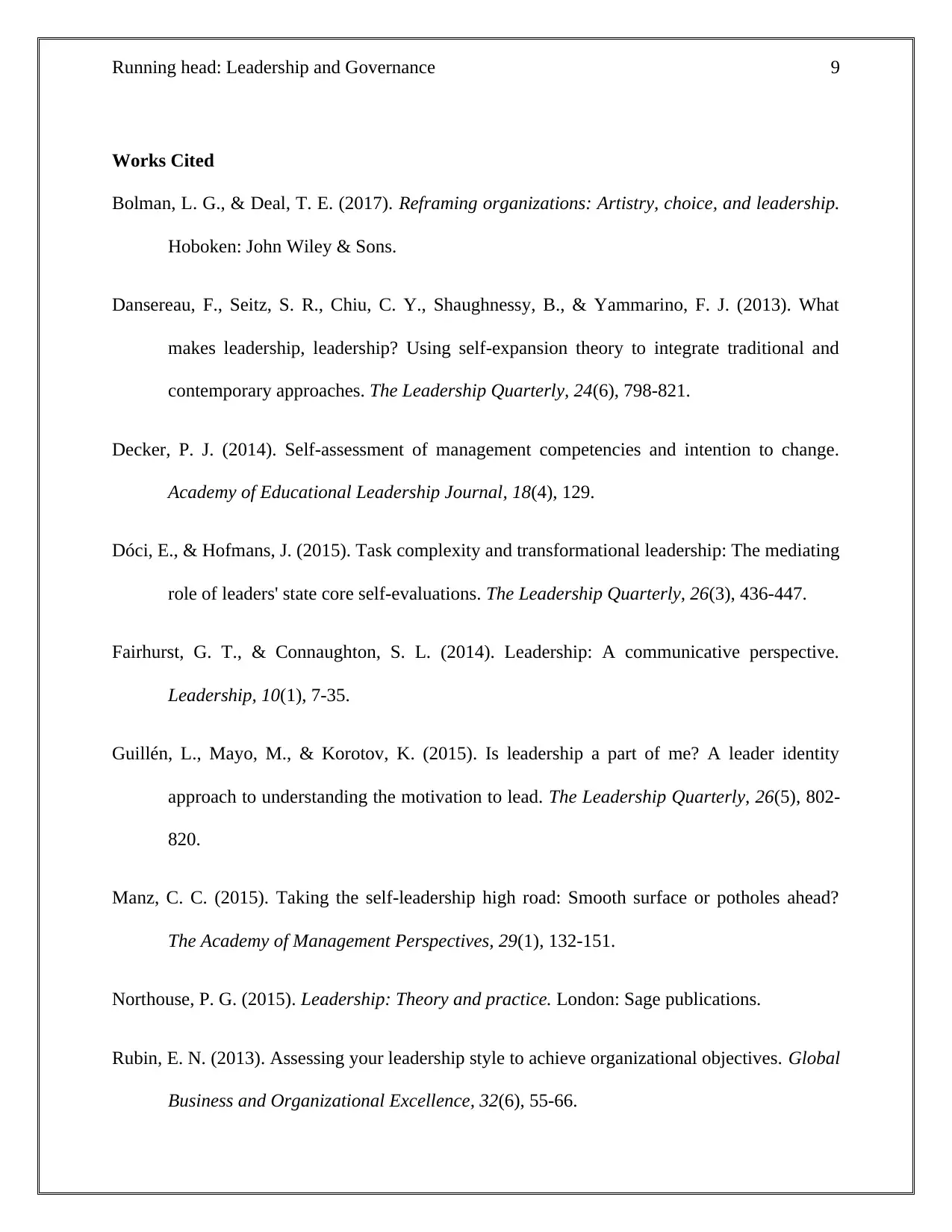
Running head: Leadership and Governance 9
Works Cited
Bolman, L. G., & Deal, T. E. (2017). Reframing organizations: Artistry, choice, and leadership.
Hoboken: John Wiley & Sons.
Dansereau, F., Seitz, S. R., Chiu, C. Y., Shaughnessy, B., & Yammarino, F. J. (2013). What
makes leadership, leadership? Using self-expansion theory to integrate traditional and
contemporary approaches. The Leadership Quarterly, 24(6), 798-821.
Decker, P. J. (2014). Self-assessment of management competencies and intention to change.
Academy of Educational Leadership Journal, 18(4), 129.
Dóci, E., & Hofmans, J. (2015). Task complexity and transformational leadership: The mediating
role of leaders' state core self-evaluations. The Leadership Quarterly, 26(3), 436-447.
Fairhurst, G. T., & Connaughton, S. L. (2014). Leadership: A communicative perspective.
Leadership, 10(1), 7-35.
Guillén, L., Mayo, M., & Korotov, K. (2015). Is leadership a part of me? A leader identity
approach to understanding the motivation to lead. The Leadership Quarterly, 26(5), 802-
820.
Manz, C. C. (2015). Taking the self-leadership high road: Smooth surface or potholes ahead?
The Academy of Management Perspectives, 29(1), 132-151.
Northouse, P. G. (2015). Leadership: Theory and practice. London: Sage publications.
Rubin, E. N. (2013). Assessing your leadership style to achieve organizational objectives. Global
Business and Organizational Excellence, 32(6), 55-66.
Works Cited
Bolman, L. G., & Deal, T. E. (2017). Reframing organizations: Artistry, choice, and leadership.
Hoboken: John Wiley & Sons.
Dansereau, F., Seitz, S. R., Chiu, C. Y., Shaughnessy, B., & Yammarino, F. J. (2013). What
makes leadership, leadership? Using self-expansion theory to integrate traditional and
contemporary approaches. The Leadership Quarterly, 24(6), 798-821.
Decker, P. J. (2014). Self-assessment of management competencies and intention to change.
Academy of Educational Leadership Journal, 18(4), 129.
Dóci, E., & Hofmans, J. (2015). Task complexity and transformational leadership: The mediating
role of leaders' state core self-evaluations. The Leadership Quarterly, 26(3), 436-447.
Fairhurst, G. T., & Connaughton, S. L. (2014). Leadership: A communicative perspective.
Leadership, 10(1), 7-35.
Guillén, L., Mayo, M., & Korotov, K. (2015). Is leadership a part of me? A leader identity
approach to understanding the motivation to lead. The Leadership Quarterly, 26(5), 802-
820.
Manz, C. C. (2015). Taking the self-leadership high road: Smooth surface or potholes ahead?
The Academy of Management Perspectives, 29(1), 132-151.
Northouse, P. G. (2015). Leadership: Theory and practice. London: Sage publications.
Rubin, E. N. (2013). Assessing your leadership style to achieve organizational objectives. Global
Business and Organizational Excellence, 32(6), 55-66.
Paraphrase This Document
Need a fresh take? Get an instant paraphrase of this document with our AI Paraphraser
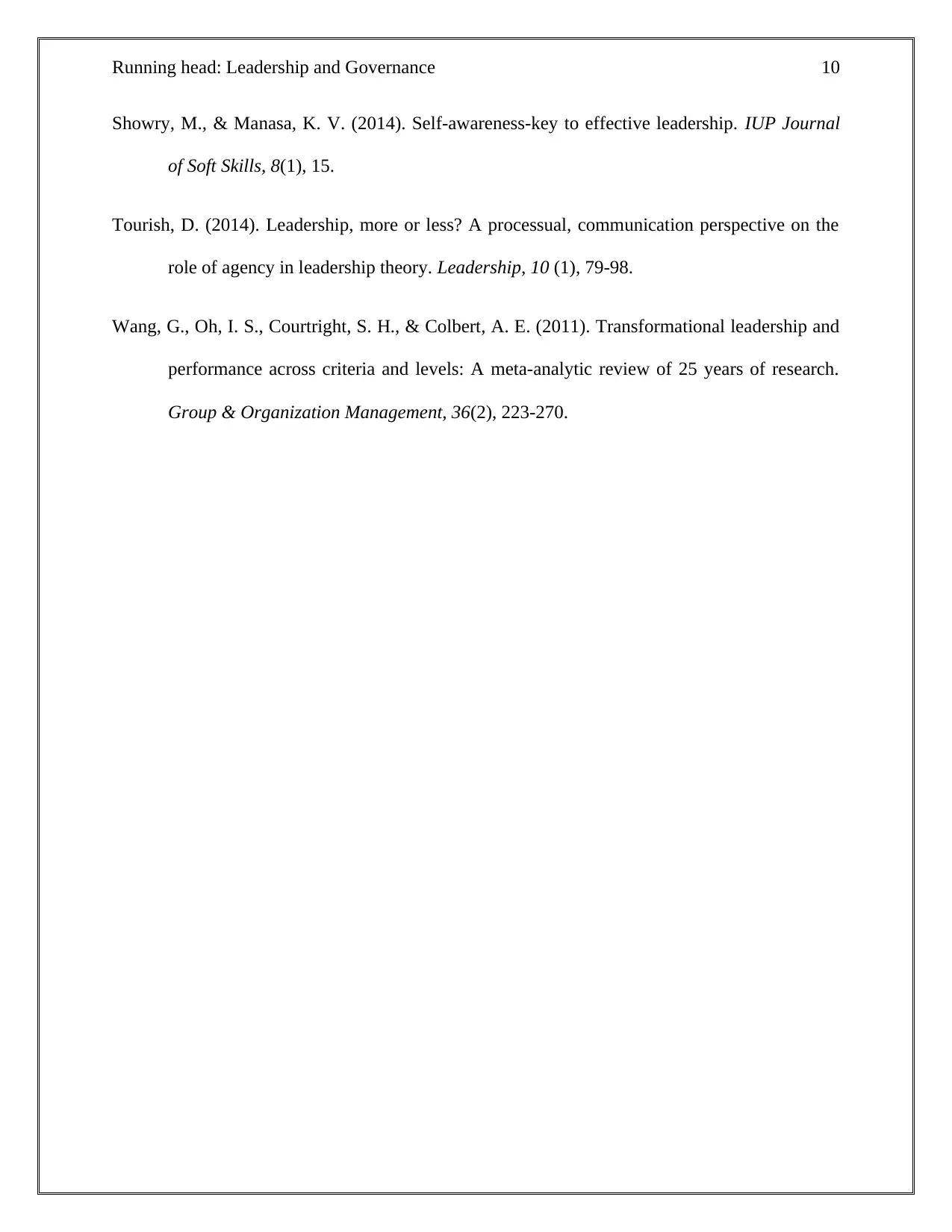
Running head: Leadership and Governance 10
Showry, M., & Manasa, K. V. (2014). Self-awareness-key to effective leadership. IUP Journal
of Soft Skills, 8(1), 15.
Tourish, D. (2014). Leadership, more or less? A processual, communication perspective on the
role of agency in leadership theory. Leadership, 10 (1), 79-98.
Wang, G., Oh, I. S., Courtright, S. H., & Colbert, A. E. (2011). Transformational leadership and
performance across criteria and levels: A meta-analytic review of 25 years of research.
Group & Organization Management, 36(2), 223-270.
Showry, M., & Manasa, K. V. (2014). Self-awareness-key to effective leadership. IUP Journal
of Soft Skills, 8(1), 15.
Tourish, D. (2014). Leadership, more or less? A processual, communication perspective on the
role of agency in leadership theory. Leadership, 10 (1), 79-98.
Wang, G., Oh, I. S., Courtright, S. H., & Colbert, A. E. (2011). Transformational leadership and
performance across criteria and levels: A meta-analytic review of 25 years of research.
Group & Organization Management, 36(2), 223-270.
1 out of 11
Related Documents
Your All-in-One AI-Powered Toolkit for Academic Success.
+13062052269
info@desklib.com
Available 24*7 on WhatsApp / Email
![[object Object]](/_next/static/media/star-bottom.7253800d.svg)
Unlock your academic potential
Copyright © 2020–2025 A2Z Services. All Rights Reserved. Developed and managed by ZUCOL.





